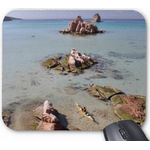After visiting the Ischigualasto Provincial Park, we drive to its neighbor, the Talampaya National Park in the province of La Rioja. We visit two of the canyons in the park, the Talampaya and the Arco Iris (Rainbow) canyons.
Stage index:
June 1, 2011: Talampaya Canyon
June 2, 2011: Rainbow Canyon
June 1, 2011: Talampaya Canyon
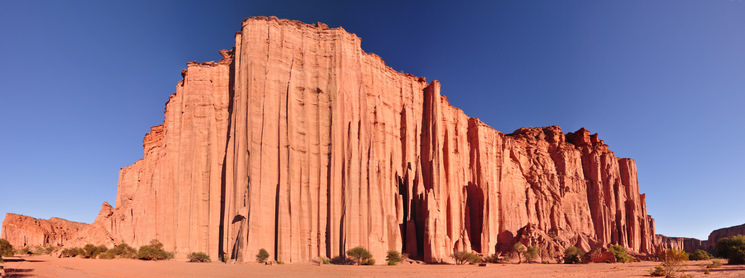
 We arrive at the Talampaya National Park just in time for the departure of the last bus of the day which will take us to the Talampaya Canyon. In this park, as in the Ischigualasto, they don’t let you visit it on your own. Unfortunately, this visit is one of the short ones, where only a small part of the canyon is accessed. In addition, both the driver and the guide are in a hurry and try to shorten the visit, but what we're seeing is too beautiful to rush through it. Although we cannot control the speed of the vehicle, we ask to stop on the way to take some pictures.
We arrive at the Talampaya National Park just in time for the departure of the last bus of the day which will take us to the Talampaya Canyon. In this park, as in the Ischigualasto, they don’t let you visit it on your own. Unfortunately, this visit is one of the short ones, where only a small part of the canyon is accessed. In addition, both the driver and the guide are in a hurry and try to shorten the visit, but what we're seeing is too beautiful to rush through it. Although we cannot control the speed of the vehicle, we ask to stop on the way to take some pictures.
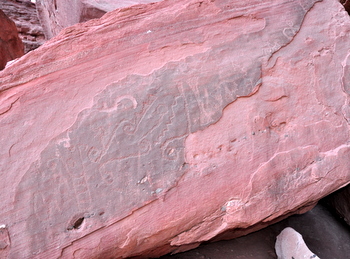 The visit focuses on a stretch of the Talampaya Canyon. To get to it we drive the dry and sandy bed of the river for a few miles till the entrance of the canyon. Suddenly, we find sandstone cliffs 600 feet high on both sides forming high plateaus. The first official stop is on a corner where a small cluster of carb trees and other native plants have grown. The natives used them as food and for medicinal purposes. On one of the rocks at the base of the wall they left petroglyphs engraved with geometric and abstract figures. From the base of the wall we can observe a curious effect of erosion. The scarce rain in this area is usually torrential. The water collected at the top of the plateaus is drained toward the edges and it concentrates on waterfalls that dissolve the mud walls. The result is a series of vertical grooves on the walls that seem like negative columns carved in them. The continuing effect of water erosion combined with wind generates other formations such as needles and other structures that the local imagination has named after animals or people. The route crosses the canyon until its exit from where we can appreciate its magnitude. Here the sun, already low, illuminates the red walls and creates shadows enhancing the beauty of the place. It's a shame we cannot spend more time here or even camp, but they call us back nervously.
The visit focuses on a stretch of the Talampaya Canyon. To get to it we drive the dry and sandy bed of the river for a few miles till the entrance of the canyon. Suddenly, we find sandstone cliffs 600 feet high on both sides forming high plateaus. The first official stop is on a corner where a small cluster of carb trees and other native plants have grown. The natives used them as food and for medicinal purposes. On one of the rocks at the base of the wall they left petroglyphs engraved with geometric and abstract figures. From the base of the wall we can observe a curious effect of erosion. The scarce rain in this area is usually torrential. The water collected at the top of the plateaus is drained toward the edges and it concentrates on waterfalls that dissolve the mud walls. The result is a series of vertical grooves on the walls that seem like negative columns carved in them. The continuing effect of water erosion combined with wind generates other formations such as needles and other structures that the local imagination has named after animals or people. The route crosses the canyon until its exit from where we can appreciate its magnitude. Here the sun, already low, illuminates the red walls and creates shadows enhancing the beauty of the place. It's a shame we cannot spend more time here or even camp, but they call us back nervously.
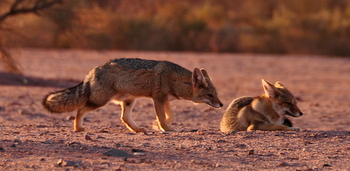 At the campground at the entrance of the park a couple of foxes come close to us. They have probably been spoiled by tourists that feed them. We set up the tent while the sun has just set over the horizon, the wind starts blowing and the temperature drops precipitously.
At the campground at the entrance of the park a couple of foxes come close to us. They have probably been spoiled by tourists that feed them. We set up the tent while the sun has just set over the horizon, the wind starts blowing and the temperature drops precipitously.
Go to top
June 2, 2011: Rainbow Canyon
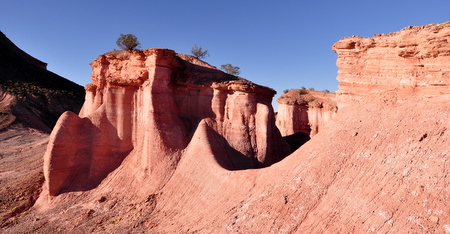 We get up at first light of the day. Incredibly, even in the middle of this desert area, the windshield of the car has a considerable layer of frost. Throwing water and setting the car heating at full power, we get a window on the ice big enough to start driving. We drive to another section of the park from which, with another official transportation, we get to the Rainbow Canyon. When we arrive at the visitor center, the office is still closed and while the sun rises above the crests and begins to warm us, we have breakfast.
We get up at first light of the day. Incredibly, even in the middle of this desert area, the windshield of the car has a considerable layer of frost. Throwing water and setting the car heating at full power, we get a window on the ice big enough to start driving. We drive to another section of the park from which, with another official transportation, we get to the Rainbow Canyon. When we arrive at the visitor center, the office is still closed and while the sun rises above the crests and begins to warm us, we have breakfast.
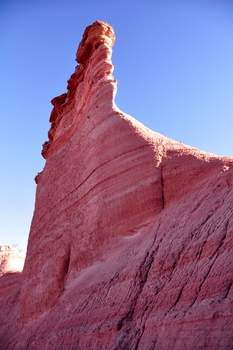 The van that takes us to the entrance of the canyon runs through several dry river beds, dodging rocks and logs stuck in the sand from the last storm. Gradually, the last river narrows and the sidewalls become higher and abrupt. Finally, our driver-guide stops the vehicle to continue on foot. In this area the strata of the 7 stages of the Triassic period, the first of the Mesozoic era (see Table of geological periods), are exposed and this is precisely what makes this place so unique as to be declared Natural World Heritage Site. The different sedimentary strata deposited over millions of years have different mineral composition and this gives this place a spectacular broad color range. On top of this, as this is compacted sand, water has eroded side canyons, ruts and unusual shapes on the walls. Throughout the tour we can also see faults in the rocks that remind us of the titanic forces that raised these sediments from the bottom of the sea as they created the Andes.
The van that takes us to the entrance of the canyon runs through several dry river beds, dodging rocks and logs stuck in the sand from the last storm. Gradually, the last river narrows and the sidewalls become higher and abrupt. Finally, our driver-guide stops the vehicle to continue on foot. In this area the strata of the 7 stages of the Triassic period, the first of the Mesozoic era (see Table of geological periods), are exposed and this is precisely what makes this place so unique as to be declared Natural World Heritage Site. The different sedimentary strata deposited over millions of years have different mineral composition and this gives this place a spectacular broad color range. On top of this, as this is compacted sand, water has eroded side canyons, ruts and unusual shapes on the walls. Throughout the tour we can also see faults in the rocks that remind us of the titanic forces that raised these sediments from the bottom of the sea as they created the Andes.
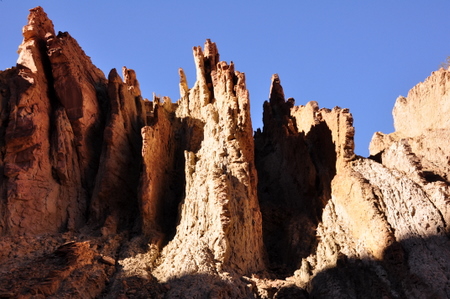 When we reach the end of the main canyon, our guide moves to a corner where the sun, high enough by now, reaches the river bed. We take the opportunity to go a little deeper, climb over the walls and, from above, appreciate better the place. On the other side we see plateaus with reddish walls, like the ones we saw yesterday in the Talampaya Canyon, plus a few very curious small conical mounds. The view down and around is breathtaking.
When we reach the end of the main canyon, our guide moves to a corner where the sun, high enough by now, reaches the river bed. We take the opportunity to go a little deeper, climb over the walls and, from above, appreciate better the place. On the other side we see plateaus with reddish walls, like the ones we saw yesterday in the Talampaya Canyon, plus a few very curious small conical mounds. The view down and around is breathtaking.
We go back to the visitor center along the same way to start the long return to San Juan.
Go to top
© 2014 Explore Pangea. All Rights Reserved. Website
Terms
of Use.

 We arrive at the Talampaya National Park just in time for the departure of the last bus of the day which will take us to the Talampaya Canyon. In this park, as in the Ischigualasto, they don’t let you visit it on your own. Unfortunately, this visit is one of the short ones, where only a small part of the canyon is accessed. In addition, both the driver and the guide are in a hurry and try to shorten the visit, but what we're seeing is too beautiful to rush through it. Although we cannot control the speed of the vehicle, we ask to stop on the way to take some pictures.
We arrive at the Talampaya National Park just in time for the departure of the last bus of the day which will take us to the Talampaya Canyon. In this park, as in the Ischigualasto, they don’t let you visit it on your own. Unfortunately, this visit is one of the short ones, where only a small part of the canyon is accessed. In addition, both the driver and the guide are in a hurry and try to shorten the visit, but what we're seeing is too beautiful to rush through it. Although we cannot control the speed of the vehicle, we ask to stop on the way to take some pictures. 






